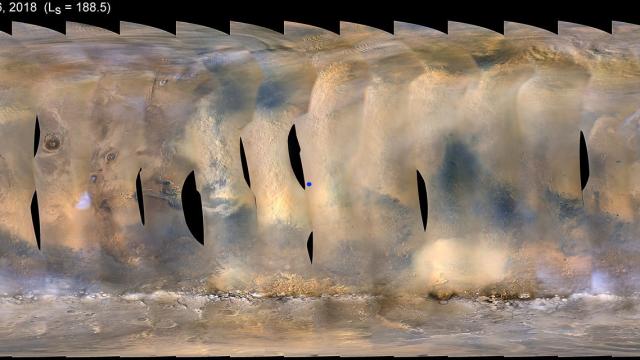A massive dust storm on Mars has forced NASA to temporarily suspend operations of its Opportunity rover.
Global map of Mars showing the growing dust storm on 6 June 2018. The blue dot shows the approximate location of Opportunity. Image: NASA/JPL-Caltech/MSSS
NASA first caught wind of the dust storm when its Mars Reconnaissance Orbiter detected traces of the emerging weather system on June 1. Within a few days, the storm exploded in size, and it now covers an area measuring 18 million km2, which is larger than North America.
NASA’s Opportunity rover is currently within the affected region, prompting mission controllers to suspend normal operations as the rover waits out the storm.
The situation is actually quite perilous. The dust storm (not to be confused with a sandstorm) is raising atmospheric opacity, or “tau”, blocking out light from the Sun, so it’s much darker at the surface than usual. On June 7, the rover’s power levels dropped appreciably. Opportunity uses solar panels to recharge its batteries, so NASA had little choice but to put the rover into a kind of hibernation mode to preserve energy.
NASA is having to manage a delicate balance, making sure the rover doesn’t run out of energy while maintaining its power-hungry survival heaters – a system that protects the rover’s batteries from freezing in the extreme cold.
“It’s not unlike running a car in the winter so that the cold doesn’t sap its battery charge,” NASA writes in a release. “There is a risk to the rover if the storm persists for too long and Opportunity gets too cold while waiting for the skies to clear.”
This isn’t the first time Opportunity has dealt with dust storm since it arrived on Mars in January 2004. In 2007, the rover rode out a similar storm that lasted for two weeks. Like now, the rover was put into a hibernation mode, and it managed to survive the ordeal. The same could not be said for Opportunity’s companion probe, Mars Spirit, which failed completely after a dust storm in 2008.
The current dust storm seems to be worse than the one in 2007 in terms of dimming. The 2007 storm produced a tau value of 5.5, while the current storm has already produced a tau of 10.8.
The good news is that Opportunity seems to be OK so far. The probe sent a hello message to NASA engineers yesterday – an encouraging sign given the storm’s increasing intensity. NASA will carefully monitor Opportunity’s power levels as the storm continues.
The temperature in Perseverance Valley, the rover’s current location, is around -29C. Counterintuitively, dust storms may limit the extreme temperature swings experienced on Mars. The swirling dust absorbs heat, raising the temperature at the surface.
Dust storms are infrequent on Mars, but they do arise from time to time. These systems often emerge without warning and escalate quickly, lasting anywhere from a few weeks to a few months. During summer in the south, the Sun warms dust particles, causing them to rise up higher into the sky. This produces more wind, which kicks up even more dust, creating a feedback loop.
In case you’re wondering, NASA’s Curiosity rover is nowhere near Opportunity and is not currently threatened by the dust storm. The two probes are about 8200km apart and on practically opposite sides of the planet. It’s lonely on Mars, but as this storm menaces Opportunity, the Red Planet suddenly seems even lonelier.
[NASA]
